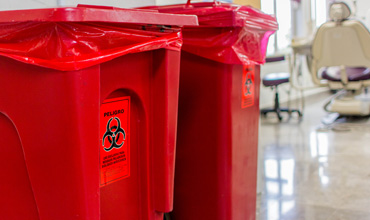Knowledge of Auxiliary Healthcare Workers on Injection Safety and Biological Waste Handling in Taraba State, Nigeria

Abstract:
Background: Individuals working in healthcare settings occasionally are at risk
of infections as a result of exposure to certain diseases causing agents. However,
in most developing countries attention on prevention is mainly focused on skilled
healthcare workers (HCWs) with “neglect” of auxiliary health workers (AHWs) who
may not be knowledgeable on job health hazard and carries high risk of exposure
to infectious agents.
Objective: To assess knowledge of auxiliary healthcare
workers on injection safety and biological waste handling as well as attitude towards
post exposure prophylaxis in the event of any exposure.
Methods:
A descriptive cross-sectional study conducted among AHWs on knowledge on injection
safety and biological waste handling in June 2016. Participants included ward orderlies
(WOs), lab attendants (LAs), compound laborers (CLs), theater attendants (TAs) and
laundry personnel (LPs) randomly selected. A semi structured questionnaire administered
to consented respondents. Data was presented as descriptive analysis and percentage
compared using Chi-square test with significant level 0.05 at 95% Confidence interval.
Results:
A total of 68 auxiliary healthcare workers consisting of male 44.1% (n=30) and female
55.9% (n=38) were interviewed. Respondent’s mean ± (SD) age was 31± 5.30 years and
ranged from 27- 55 years. Knowledge on injection safety and biological waste handling
among AHWs showed (WOs) 42/68 (61.7%), (LAs) 5/68 (7.4%), (CLs) 9/68 (13.2%), (TAs)
5/68 (7.4%) and (LWs) 7/68 (10.3%). A significant difference in knowledge on injection
safety and biological waste handling among AHWs was observed. (X2= 1.56,
df 4, critical value 9.488 at 95% confidence level.
Conclusion: There is low level of knowledge on
needle stick injury (NSI), biological waste handling and poor attitude towards PEP
among auxiliary healthcare workers in GH Wukari and GH Zing.
Keywords: Knowledge, Auxiliary, Biological, Injection, Waste, Safety
References:
[1]. Amira CO, Awobusuyi JO (2014). Needle-stick injury
among health care workers in hemodialysis units in Nigeria: a multi-center study.
Int J Occup Environ Med 2014; 5:1-8.
[2]. Centers for Disease Control and Prevention: Exposure
to Blood: What Healthcare Personnel Need to Know. 2003, Available: http://www.cdc.gov/HAI/pdfs/bbp/Exp_to_Blood.pdf.
Accessed June 2016 www.cdc.gov/niosh Accessed 17th July, 2016
[3]. CDC MMWR / November 25, 2011 / Vol. 60 / No. 7
[4]. Dimie Ogoina, Kemebradikumo Pondei, Babatunde Adetunji,
George Chima, Christian Isichei, and Sanusi Gidado (2014). Prevalence and Determinants
of Occupational Exposures to Blood and Body Fluids Among Health Workers in Two Tertiary
Hospitals in Nigeria Afr J Infect Dis. 8(2): 50–54.
[5]. Ejiofor O S, Emechebe G O, Igwe W C, Ifeadike C
O, Ubajaka C F. Hepatitis C virus infection in Nigerians. Niger Med J 2010;51:173-6
[6]. https://en.wikipedia.org/wiki/Occupational_safety_and_health
Accessed 13th June, 2016
[7]. http://www.tandfonline.com/doi/abs/10.1179/oeh.2004.10.4.451
Accessed 13th June, 2016
[8]. http://www.who.int/occupational_health/topics/hcworkers/en/.
Accessed 14th June, 2016
[9]. http://deolaonline.com/factsheets-on-lassa-fever/.
Accessed 14th June, 2016
[10]. https://naca.gov.ng/article/hivaids-prevalence-rate
Accessed 18th July, 2016
[11]. http://en.wikipedia.org/wiki/List_of_Nigerian_states_by_population
Accessed 13th July, 2016
[12]. http://www.cdc.gov/mmwr/preview/mmwrhtml/rr5210a1.htm.
Accessed 14th July, 2016
[13]. http://www.who.int/immunization/topics/hepatitis/en/
Accessed 14th July, 2016
[14]. http://nigeria.usembassy.gov/uploads/images/McLyWtfPi8-VIVCnFmfaLQ/Injection_Safety_Assessment_in_Nigeria.pdf
Accessed 15th July, 2016
[15]. Karwowski W, Jang RL, Rodrick D, Peter MQ, Cronin
SN. Self-evaluation of biomechanical task demands, work environment and perceived
risk of injury by nurses: a field study. Occup Ergon. 2005;5:13–27.
[16]. Musa B, Bussell S, Borodo M M, Samaila A A, Femi
O L. Prevalence of hepatitis B virus infection in Nigeria, 2000-2013: A systematic
review and meta-analysis. Niger J ClinPract 2015;18:163-72
[17]. O. Erhabor,
O.A. Ejele and C.A. Nwauche (2007). Epidemiology and management of occupational
exposure to blood borne viral infections in resource poor settings: The case for
availability of post exposure prophylaxis. Nigerian Journal of Clinical Practice,
June 2007 Vol 10(2): 100-104
[18]. OS Elkanah, AL Okoye, OE Debby-Sambo. Prevalence
of Hepatitis-B Surface Antigen among Blood Donors in Jalingo, Taraba State, Nigeria
Nigerian Journal of Parasitology Vol 34, No 2 (2013
[19]. OguamanamOkezieEnwere, Kevin ChiekulieDiwe 2014:
Knowledge, perception and practice of injection safety and healthcare waste management
among teaching hospital staff in south east Nigeria: an intervention study Pan Afr
Med J. 2014; 17: 218.
[20]. RuhiToraman, FatmaBattal, Kirstin Ozturk&BetulAkcin
(2011) Sharps Injury Prevention for Hospital Workers, International Journal of Occupational
Safety and Ergonomics, 17:4, 455-461, DOI: 10.1080/10803548.2011.11076908
[21]. Soad A. HabibaGhadeer A. Alrashidi, Afaf E.M. Al-otaibi, Ghizayel R. Almutairi, Gamal Makboul and Medhat K. El-Shazl (2012): Knowledge, attitude and behavior of health care workers regarding hepatitis B infection in primary health care, Kuwait. Greener Journal of Medical Sciences Vol. 2 (4), pp. 077-083. Taraba State strategic health development plan (2010 – 2015)

